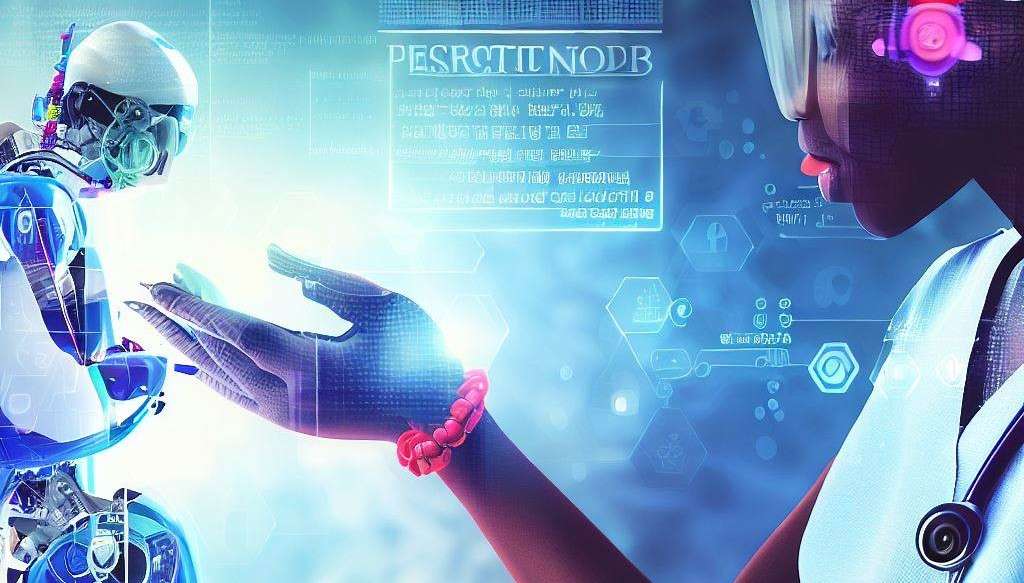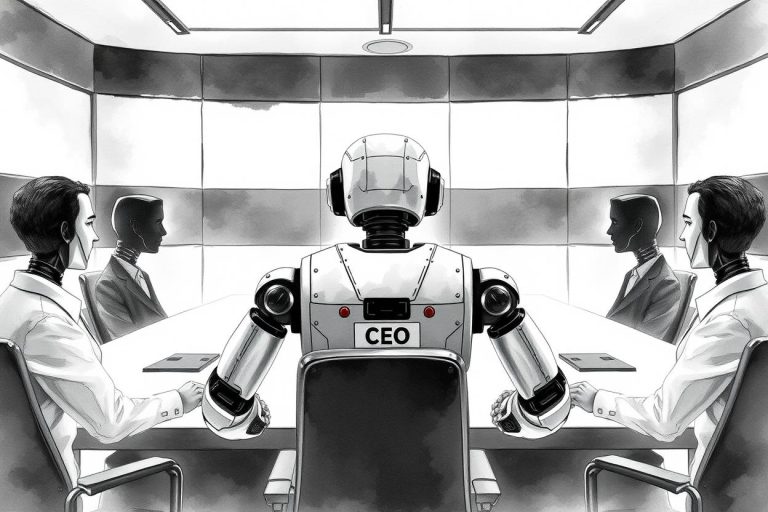The future is here: Explore the Top AI Trends that will shape 2023 and beyond

From Sci-Fi to Reality: The Groundbreaking AI Trends of the Future
Innovation in artificial intelligence is advancing at an unprecedented rate, and with it comes the potential to revolutionize industries and transform the way we live and work. The future of technology is both exciting and daunting, but staying up-to-date with the latest AI trends and developments will be crucial for businesses and individuals looking to thrive in this rapidly changing landscape. In this article, we’ll explore some of the most promising areas of AI research and development, and what they could mean for the future of technology and society.
NLP and Creative AI – How GPT-4 and ChatGPT continuously revolutionizing businesses and what they can do to keep up
Natural Language Processing (NLP) is one of the hottest fields in AI, and it’s expected to continue growing in 2023 and beyond. NLP tools, which are used to analyze, understand and generate human language, have a wide range of applications in fields like healthcare, education, and customer service. In the next few years, we can expect to see more sophisticated NLP models that can understand and respond to human language more accurately and with greater nuance.
Generative Pre-trained Transformer 4 (GPT-4)
GPT-4 is OpenAI’s large multimodal language model that generates text from textual and visual input. Open AI is the American AI research company behind Dall-E, ChatGPT and GPT-4’s predecessor GPT-3.
GPT-4 can handle more complex tasks than previous GPT models. The model exhibits human-level performance on many professional and academic benchmarks, including the Uniform Bar Exam. It was developed to improve alignment and scalability for large models of its kind.
This is part of a larger trend in AI-generated content. Technologies like GPT-4, ChatGPT, Google Bard, DALL-E and more that will shape the future of businesses in 2023.
ChatGPT – One of the Top AI Trends in 2023 that’s here to stay
ChatGPT is a conversational AI chatbot powered by the GPT language model developed by OpenAI. It allows users to have natural language conversations with the bot on a wide range of topics.
DALL-E & Digital Art Creators AI Tools
OpenAI’s DALL-E is an AI program which creates images from descriptions. It can make a wide range of pics, from realistic to surrealistic. This tech is transforming businesses’ creative tasks, such as marketing and advertising. It enables quick and efficient image production without human help.
There are powerful tools for small businesses such as Jasper.AI that combines the cutting-edge NLP and Creative AI capabilities that allow anyone to access and implement this technologies into their AI Marketing and general business processes.
Quantum Computers and AI – Leading the way to hyper performance

Quantum computing and AI are both computationally intensive, and the combination of the two has the potential to unlock incredible new capabilities. By using quantum computing, AI models can be trained much faster and can process vast amounts of data, leading to breakthroughs in fields such as drug discovery, financial modeling, and climate modeling.
Quantum computing and processing vast amounts of data
One of the biggest challenges in AI is the need for massive amounts of data to train machine learning models. Quantum computing can help to address this challenge by allowing AI systems to process much larger datasets in a fraction of the time it would take a classical computer. Google’s quantum computer was able to solve a problem in just a few minutes that would take a classical computer thousands of years to solve. This speedup has the potential to transform the field of machine learning by allowing AI systems to train on much larger datasets than is currently possible.
Developing new quantum algorithms for AI
Another area where quantum computing can benefit AI is in the development of new algorithms. Quantum algorithms are fundamentally different from classical algorithms and can solve certain problems much faster than classical algorithms. By developing new quantum algorithms for AI, researchers can create new AI models that are more accurate and more efficient than their classical counterparts.
Google’s quantum supremacy and investment in AI
Google’s announcement of quantum supremacy in 2019 was a major milestone in the development of quantum computing. This achievement demonstrated the immense computational power of quantum computing and opened up new possibilities for the field. Google is also investing heavily in the development of AI, with projects such as Google Brain and Google DeepMind. By combining its expertise in quantum computing and AI, Google has the potential to unlock new capabilities that could transform a wide range of industries.
From Code to Clicks: How Low Code/No Code is Leading the AI Trends of Democratization
The low-code, no-code trend in website and app development is now being adopted in AI, enabling businesses to customize their intelligent systems quickly and efficiently using pre-built templates and drag-and-drop methods. This trend is accelerating the integration of AI into existing workflows and scaling AI usage within corporate setups. These tools can automate repetitive tasks such as invoicing, form filling, and contact validation, and can also be used to program AI tools for data analysis of current processes and visualization of future performance. This trend is expected to continue, with cloud service providers likely to integrate AI into their offerings due to its increasing adoption in the long run.
Benefits and growth of low-code / no-code tools
IT modernization using low-code, no-code tools is more cost-effective and completed faster (as short as three days) than traditional methods, with 66% of developers already using or planning to use them in 2023. Gartner forecasts that by 2026, “citizen developers” (those who did not take formal coding courses) will make up 80% of low-code tool development users. These tools are democratizing AI and providing opportunities for businesses of all sizes to integrate AI into their workflows more easily.
AI tools for data analysis and visualization
AI tools have revolutionized data analysis and visualization. They make it easy for businesses of all sizes to access powerful insights. These low-code tools let non-technical users create sophisticated data models and generate compelling visualizations.
Popular AI tools include Power BI, Tableau, and Google Data Studio. These offer features like interactive dashboards, data drill down, and real-time collaboration.
AI integration by cloud service providers
Cloud service providers are incorporating AI into their offerings, providing access to advanced tech for companies of all sizes. This trend is set to revamp operations in the near future, revealing new possibilities for growth and invention.
AI integration with cloud services permits businesses to utilize machine learning, NLP, and computer vision to automate routine jobs, acquire knowledge from vast amounts of data, and offer individualized customer experiences. This not only streamlines activities but also helps maintain a competitive edge in a rapidly transforming market.
By selecting low-code AI solutions, businesses can construct custom apps that suit their needs without requiring a huge team of data scientists or developers. This allows even small to mid-sized companies to take full advantage of AI and go up against larger firms.
Growing risks of AI in cybersecurity – AI Trend or Necessity?

Advanced cybersecurity is a must in the ever-evolving tech world. Companies are becoming more digital, and the danger of cyber attacks is real. To protect your business and stay ahead of any issues, you need to understand and use sophisticated cybersecurity tools.
AI can play a crucial role in mitigating cybersecurity risks by handling data, including classification, cataloging, integration, and quality control, as well as vulnerability management and threat detection through predictive AI. Quick detection and response can save businesses an average of USD3 million and reduce breach lifecycles by 74 days. Growing cyber threats may also push the insurance market to adopt new technologies and strategies to assess and manage cyber risks, leading to the introduction of risk-based pricing and exemption clauses for ransomware and cyberattacks.
AI can spot patterns, detect breaches, and respond proactively. It also predicts and prevents attacks, using machine learning algorithms. This shortens the attack lifecycle and saves time spent on manual analysis. AI strengthens security and saves resources. Embrace the power of AI for better cybersecurity and invest in an AI-powered solution to stay ahead of threats and keep your business safe.
Ethics and Regulations in Artificial Intelligence: A Critical AI Trend for Safe Implementation
Generative AI has many benefits, but concerns about its misuse have led to calls for regulation. One major concern is the production of deep fake videos, which cybercriminals can use for fraudulent activities such as slander, blackmail, revenge, coercion, or extortion. Additionally, there are questions about the boundaries of original and proprietary content.
To address these concerns, the AI sector expects users and customers to demand transparency, safety, and responsible practices. Governments around the world are also taking steps to regulate the use of AI. For example, the New York City Department of Consumer and Worker Protection has passed an AI Law (New York City Local Law 144) that requires employers to meet bias audit requirements before using automated tools for evaluating job applicants. Hiring teams should also inform candidates about their use of these tools for recruitment and job advertisements.
Similarly, the European Council submitted a proposal to regulate AI in 2021, which classifies AI applications and systems into prohibited, high-risk, and low-risk categories. The proposed legislation, known as the AI Act, aims to serve as the AI counterpart of the General Data Protection Regulation. It is expected to provide a framework for the safe and ethical use of AI in Europe and beyond.
While AI has the potential to transform many industries and improve our lives in countless ways, it is crucial to regulate its use to prevent harmful consequences. By ensuring transparency, safety, and responsible practices, we can create an environment where the benefits of AI can be fully realized while minimizing the risks.
The pioneers in the field, including names such as Elon Musk, Steve Wozniak and Mira Murati, the CTO of Open AI, the company behind GPT-4 and Chat GPT.
Pro Tip: Keep up with developments in AI regulation and use them for your company’s AI strategy, as well as making sure you are on the good side of the law at all times.
The Advantages of Cobots: AI-Human Collaboration in Various Industries, a necessary AI Trend?

The Rise of Cobots in Response to Increasing Reliance on AI
The increasing use of AI in industries has resulted in the emergence of cobots, which are collaborative robots designed to work alongside humans. These machines, equipped with AI features, can perform repetitive and physically strenuous tasks, freeing up human workers to focus on more specialized duties. Furthermore, the use of cobots can enhance efficiency and productivity, as well as improve safety and lower costs for repairs or injury.
Cobots in Various Industries
Cobots are becoming more widespread in various industries, including automotive manufacturing, agriculture, healthcare and hospitality, electronics, and defense.
- In automotive manufacturing, cobots are utilized for car assembly, spray painting, surface polishing, systems checking, and retrofitting or reconstructing car production lines for electric models.
- In agriculture, cobots are used for drones for seed planting, fertilizer and pesticide application, trespasser and invasive species tracking, and LED lighting and hydroponics for indoor farms.
- Electronics can benefit from cobots’ quality inspection for phone chips, phone chip processors, and printed circuit boards.
Addressing Labor Shortages and Supply Chain Issues – AI Trend or necessity?
Cobots can also address labor shortages and supply chain issues in various industries. The healthcare, construction, and defense industries may replace traditional training methods with VR and AR-based learning for safety and reduced spending.
Overall, the rise of Cobots in various industries has proven to be advantageous in enhancing efficiency, productivity, and safety. In the future, the continued development of AI-human collaboration is expected to bring about further advancements and innovations.
Advancements in Healthcare: The Role of Artificial intelligence in Improving Patient Care and Diagnosis – AI Trend that can save lives

AI is transforming healthcare, revolutionizing medical diagnosis, drug discovery, and patient care. By analyzing patient data, AI identifies patterns, leading to accurate diagnoses, personalized treatments, and better outcomes. It can also address healthcare challenges, such as staffing shortages and rising costs.
- Medical Diagnosis: AI improves medical diagnosis by analyzing medical images and patient data, identifying diseases and treatment options. It develops patient-specific treatment plans and predicts disease risks, providing personalized care.
- Drug Discovery: AI uses machine learning to analyze data, identifying drug targets and predicting new drug efficacy. It reduces the time and cost of developing new treatments.
- Patient Care: AI improves patient care through chatbots and virtual assistants, helping patients manage conditions and monitoring progress. Wearables and robots provide real-time data, allowing remote monitoring and assistance.
- Addressing Healthcare Challenges: AI automates tasks, provides medical insights, and improves training through virtual and augmented reality. It reduces costs and improves efficiency, addressing staffing shortages and rising costs.
The AI Trends in healthcare are promising, with ongoing advancements and innovations expected to further transform the industry.
Digital twin technology and its applications: Among Top AI Trends that will change the future of business.
Digital twinning is an emerging trend that involves creating a virtual model or replica of a physical object, system, or process using data captured from sensors, cameras, and other sources. This digital model is then used to simulate and optimize the performance of the real-world object, system or process. With the help of AI, digital twinning is becoming more powerful and effective, leading to a range of benefits and applications.
One of the main benefits of digital twinning is the ability to optimize performance and reduce costs. By simulating the behavior of a real-world object or system, engineers and medical professionals can identify potential issues and test various solutions in a safe and controlled environment before implementing changes in the real world.
- Manufacturing: digital twinning is used to improve the efficiency of manufacturing processes and optimize production lines.
- Healthcare: digital twinning is used to create virtual models of organs, tissues, and entire patients to help doctors better diagnose and treat diseases.
- Construction and architecture: digital twinning is used to simulate building designs and optimize energy usage, building materials, and construction workflows.
- Transportation: digital twinning is used to create virtual models of vehicles and transportation systems to improve safety, efficiency, and maintenance.
- Energy: digital twinning is used to monitor and optimize energy production and consumption, especially in renewable energy sources such as wind and solar power.
The AI Trends of Voice Technology, Identity Protection and Cloning
Voice technology and AI are rapidly advancing, leading to exciting developments in the areas of identity protection and voice cloning. Voice biometrics is becoming more popular, with businesses using voiceprints instead of traditional passwords or PINs for more secure and user-friendly authentication. Banks are also using speech authentication to allow clients to access their accounts.
Voice cloning is another area of AI development with a growing market. This technology uses a person’s voice sample to generate new audio, which can be useful for creating content for films and video games, localizing content in different languages, and even preserving a person’s voice after their passing. Companies like VoCapsule offer a “voice bank” platform called My Legacy Voice, which members can access if they start having speech difficulties or designate “primary recipients” to access the data after their passing.
As voice technology and AI continue to advance, we can expect to see even more exciting developments in the future, with new and innovative applications that will transform the way we interact with technology. Voice technology is not just a top AI trend in 2023 but is expected to stay for the years to come.
To stay ahead of the game, businesses must continually stay up-to-date with this developing technology, to increase customer engagement.
- Biometrics measure and analyze human features.
- Voice authentication verifies identity by voice pattern.
Both technologies are highly secure and hard to manipulate. They provide personalized identification. This stops identity theft, fraud, and other security breaches. Customers are satisfied and trust businesses more. The tech protects systems and data from unauthorized access and info theft.
AI-generated voice content and voice cloning – An AI Trend that creates new opportunities
AI lets us make synthetic voices that sound like humans. This makes it easier to create voiceovers, audiobooks and other voice-related content quickly and cost-effectively. Voice cloning, on the other hand, allows users to clone their own voices. These clones can be used for personalized voice assistants, chatbots, and more. So, businesses can now use cutting-edge tech to better connect with their customers.
AI for personalization – Top AI Trend in 2023 that will boost customer satisfaction and revenues for businesses

AI for personalization is ready to revolutionize customer connections with businesses. It can analyze customer data to craft experiences and recommendations that are tailored to individual preferences. This can result in customer satisfaction skyrocketing and loyalty growing.
Technology is advancing quickly, therefore, companies that invest in AI for personalization now have a massive advantage for the future. By understanding your customers from data insights to using tools such as Jasper.ai and Surfer SEO to craft your content and copywriting creation to appeal to your audience more specifically while ranking higher in search engines, ultimately businesses will increase their bottom lines and customer engagement.
Personalization in eCommerce and entertainment
AI is transforming personalization into a trend. It helps businesses analyze customer information, so they can customize the experience. For example, Netflix can recommend content based on user preferences.
AI-powered personalization will shape how businesses operate in the future. Companies who don’t adopt these technologies will lose out. AI solutions help businesses attract customers, better their products, and make more money.
If you’re a business owner, invest in AI-powered personalization solutions. If you’re a customer, you can expect more personalized shopping and entertainment experiences.
The AI personalization tools are created to make life easier and automate tasks, in order for your team to focus on the bigger picture. Check our guide for AI Marketing automation here.
Improving engagement in the workplace
Understand your employees’ needs and preferences to improve engagement in the workplace. AI personalization is here to help. It can analyze data on individual employees and offer tailored solutions. For example, personalized training, benefits, and schedules. AI can also identify trends and patterns in behavior, so companies can address issues before they become big problems.
How Artificial intelligence is revolutionizing the automotive industry by improving road safety and efficiency.
Adoption of AI-based driver monitoring systems in the automotive industry
AI-based driver monitoring systems are one of the top 10 AI trends that have a massive impact on the world at scale. These systems use AI and ML algorithms to monitor driver behavior, such as attention, level of drowsiness, and distractions. They alert drivers in case of danger. This tech can prevent accidents from human error, lower insurance costs, and save lives.
Adopting AI-based driver monitoring systems is important for road safety and improving auto industry efficiency. AI revolutionizes the auto industry with advanced driver assistance, autonomous driving, and predictive maintenance, making it safer, greener, and more connected.
F.A.Q. – All your questions related to AI Trends in 2023
What is NLP and how is it related to Creative AI?
Answer: NLP stands for Natural Language Processing, and it refers to the ability of machines to understand and generate human language. Creative AI uses NLP to create text, images, and other types of content that are difficult to distinguish from human-made content. The most well known model is ChatGPT build on GPT-3 / GPT-4 by OpenAI Labs.
What are Cobots and their advantages in the workplace?
Answer: Cobots, or collaborative robots, are designed to work alongside humans in a variety of settings. They can improve safety, increase productivity, and reduce costs by automating repetitive or dangerous tasks.
What are Quantum Computers and how are they related to AI?
Answer: Quantum computers have the potential to revolutionize AI by allowing machines to process large amounts of data more quickly and efficiently. They could also enable AI to solve complex problems that are currently beyond the reach of classical computers.
Why is Ethics and Regulations of AI important?
Answer: AI has the potential to transform many aspects of society, but it also raises a number of ethical and regulatory issues. It’s important to ensure that AI is developed and used in a responsible and transparent manner, and that its benefits are shared fairly across society.
How is AI being used in cybersecurity?
Answer: AI is being used in cybersecurity to detect and respond to cyber threats more quickly and accurately. It can also help to identify vulnerabilities in networks and systems, and to develop more effective security strategies.
What is Low Code / No Code, and how anyone can build AI Apps?
Answer: Low Code / No Code refers to the development of software and applications without the need for extensive coding knowledge. This can help to make AI more accessible and easier to use for people with diverse backgrounds and skill sets, which can help to democratize the technology.
What is Digital Twin Technology, and how is it being used in industry?
Answer: Digital Twin Technology involves creating a virtual replica of physical objects or systems, which can be used to simulate and optimize performance. It is being used in a variety of industries, including manufacturing, healthcare, and transportation, to improve efficiency and reduce costs.
How is AI being used in Healthcare?
Answer: AI is being used in Healthcare to help diagnose and treat patients more accurately and efficiently. It can also help to identify patterns and trends in large amounts of medical data, which can improve patient outcomes and advance medical research.
How is AI being used for personalization in business and customer care?
Answer: AI is being used to analyze customer data and provide personalized recommendations and experiences. This can help businesses to improve customer satisfaction and loyalty, and to increase sales and revenue.
How is AI being used in voice technology?
Answer: AI is being used in voice technology to enable machines to understand and respond to human speech. This is being used in a variety of settings, including virtual assistants, voice-controlled devices, and voice-enabled customer service.
How is AI being used in the Automotive industry and self-driving cars?
Answer: AI is being used in the Automotive industry to develop self-driving cars that can operate more safely and efficiently than human drivers. It can also help to improve vehicle performance, reduce maintenance costs, and enhance the overall driving experience.
What are the top AI Trends in 2023?
- NLP and Creative AI
- Advantages of Cobots
- Quantum Computers and AI
- Ethics and Regulations of AI
- AI in cybersecurity
- Low Code / No Code and democratization of AI
- Digital Twin Technology
- AI for Healthcare
- AI for personalization in business / Customer care
- AI in voice technology
- AI in Automotive industry and self-driving cars




